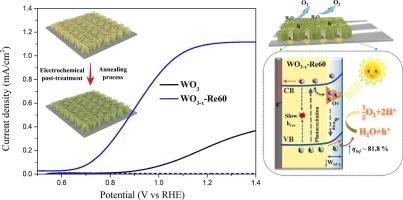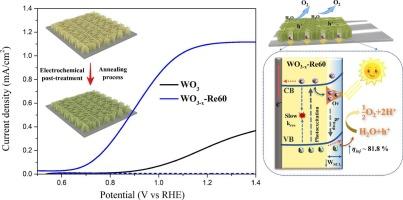Boosted charge carrier dynamics in WO3 photoanodes engineered through a one-step electrochemical post-treatment for efficient photoelectrochemical water splitting
IF 6.9
2区 材料科学
Q2 CHEMISTRY, PHYSICAL
引用次数: 0
Abstract
Strengthening intrinsic charge transport via defect engineering is an effective strategy to optimize the photoelectrochemical (PEC) water splitting properties of tungsten oxide (WO3) photoanode. In this work, a modified and effective electrochemical post-treatment approach has been developed to introduce abundant oxygen vacancies into highly-ordered WO3 nanoplate arrays, yielding oxygen-deficient WO3-x photoanode. Electrochemical tests and energy band structural analyses reveal that the generated oxygen vacancies, acting as shallow donors, significantly increase the overall carrier density, electrical conductivity, and built-in electric field (band bending), thereby contributing to the promotion of both bulk charge separation and interfacial charge injection efficiency (up to ∼ 90 % at 1 VRHE). As a result, the optimized WO3-x-Re60 photoanode demonstrates a dramatically improved photoresponse, delivering a maximum photocurrent density of 1.1 mA/cm2 at 1.23 VRHE, representing a 440 % increment over the pristine WO3, and is simultaneously accompanied by a negatively shifted onset potential of 0.24 V and boosted photon-to-current conversion efficiency. Overall, this work elucidates the critical role of oxygen vacancies in governing charge-carrier dynamics in WO3 and demonstrates a practical defect-engineering strategy for designing efficient photoanodes toward solar-driven water oxidation.


通过一步电化学后处理提高WO3光阳极的载流子动力学,实现高效的光电化学水分解
通过缺陷工程强化本征电荷输运是优化氧化钨(WO3)光阳极光电分解水性能的有效策略。在这项工作中,我们开发了一种改进的、有效的电化学后处理方法,在高度有序的WO3纳米板阵列中引入了丰富的氧空位,从而产生了缺乏氧的WO3-x光阳极。电化学测试和能带结构分析表明,生成的氧空位作为浅层供体,显著提高了载流子总密度、电导率和内置电场(带弯曲),从而促进了体电荷分离和界面电荷注入效率(在1 VRHE下高达 ~ 90 %)。结果表明,优化后的WO3-x- re60光阳极表现出了显著改善的光响应,在1.23 VRHE下提供了1.1 mA/cm2的最大光电流密度,比原始WO3增加了440 %,同时伴随着0.24 V的负移电位和提高的光子-电流转换效率。总的来说,这项工作阐明了氧空位在WO3中控制载流子动力学中的关键作用,并展示了设计高效的太阳能驱动水氧化光阳极的实用缺陷工程策略。
本文章由计算机程序翻译,如有差异,请以英文原文为准。
求助全文
约1分钟内获得全文
求助全文
来源期刊

Applied Surface Science
工程技术-材料科学:膜
CiteScore
12.50
自引率
7.50%
发文量
3393
审稿时长
67 days
期刊介绍:
Applied Surface Science covers topics contributing to a better understanding of surfaces, interfaces, nanostructures and their applications. The journal is concerned with scientific research on the atomic and molecular level of material properties determined with specific surface analytical techniques and/or computational methods, as well as the processing of such structures.
 求助内容:
求助内容: 应助结果提醒方式:
应助结果提醒方式:


